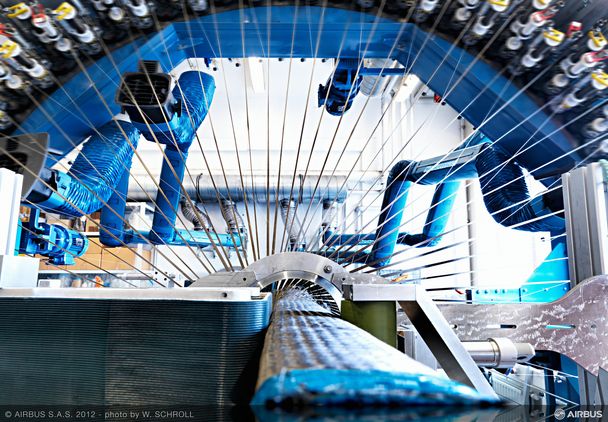Composites: Airbus continues to shape the future

Composite materials have been called the shape of aerospace’s future. With their winning combination of high strength, low weight and durability, it’s easy to see why. For more than 30 years, Airbus has pioneered the use of such materials in its commercial jetliners, from the cornerstone A310’s vertical stabiliser to today’s A350 XWB – on which more than half of the aircraft’s structure is composite.
In essence, a composite material is made from two or more constituent materials with different physical or chemical properties. When combined, the composite material exhibits beneficial physical characteristics quite different from what the individual components alone can provide. Commonly-recognised composites in everyday life include plywood and reinforced concrete.
From nose to tail, Airbus utilizes advanced composites in its jetliner product line that have been at the forefront of materials science. One particular standout material is carbon-fibre reinforced plastic, or CFRP. Composed of carbon fibres locked into place with a plastic resin, CFRP offers a better strength-to-weight ratio than metals and has less sensitivity to fatigue and corrosion. In short, it’s lighter than aluminium, stronger than iron, and more corrosion-resistant than both.
Like all composites, the strength of CFRP results from the interplay between its component materials. By themselves, neither the carbon fibres nor the resin is sufficient to create a product with the desired characteristics to be integrated on an aircraft. But once combined in multiple, integrated layers and bonded, the CFRP airframe component or aerostructure takes on the strength and load-bearing properties that make it ideal for aviation use.
Composites go to new heights on the A350 XWB
The application of carbon-fibre reinforced plastic reached new proportions with the A350 XWB, which boasts a significant application of composites throughout. For example, most of the A350 XWB's wing is comprised of the lightweight carbon composites, including its upper and lower covers. Measuring 32 metres long by six metres wide, these are among the largest single aviation parts ever made from carbon fibre.
With CFRP, not only is the jetliner’s airframe tougher and stronger airframe, the reduction in weight enables it to carry more passengers, burn less fuel, fly farther…or combinations of the three.
With composites a jetliner’s airframe can be tougher stronger and lighter…while also requiring less maintenance when in airline operation.
While initially more expensive to produce than traditional metallic parts, CFRP components can save aircraft operators money on future maintenance costs since the material doesn’t rust or corrode. An A350 XWB, for example, requires 50% fewer structure maintenance tasks, and the threshold for airframe checks is at 12 years compared to eight for the A380.
In CFRP production, thousands of microscopically thin carbon threads are bundled together to make each fibre, which joins others in a matrix held together by a robust resin to achieve the required level of rigidity. The composite component is produced in precisely shaped sheets laid atop each other and then bonded, typically using heat and pressure in an oven called an autoclave, resulting in a high quality composite.
Parts such as fuselage and wings can make extensive use of composites as the required fibre loading – the way the way the fibres are laid up and cured in the autoclave – is simple. However, parts requiring complex loading will, for the foreseeable future, continue to use metal.
From thermoset to thermoplastic composites
The two most commonly used types of CFRP are ‘thermoset’ and ‘thermoplastic.’ While thermoset CFRPs are currently more widespread in the aeronautics industry, thermoplastics are gaining popularity because of their recyclability – an important lifecycle consideration that has long been a factor against wider CFRP adoption.
A key difference between thermoset and thermoplastic materials is what happens during the curing process. When cured in the autoclave, thermoset material undergoes a chemical reaction that permanently changes its makeup. A thermoplastic part, though, can be re-melted and still maintain its composition.
That difference makes thermoplastics attractive since Airbus and its suppliers produce hundreds of tonnes of scrap composites each year. While scrap thermoset resin cannot be reused, thermoplastic scrap can be used in a variety of ways and in a number of sectors beyond aeronautics.

